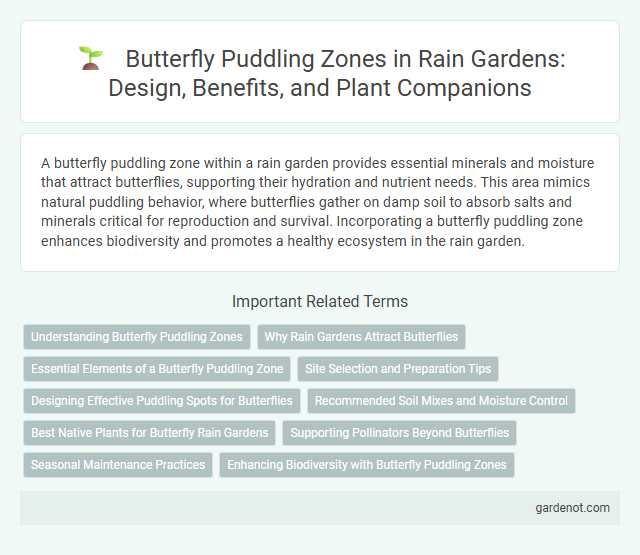A butterfly puddling zone within a rain garden provides essential minerals and moisture that attract butterflies, supporting their hydration and nutrient needs. This area mimics natural puddling behavior, where butterflies gather on damp soil to absorb salts and minerals critical for reproduction and survival. Incorporating a butterfly puddling zone enhances biodiversity and promotes a healthy ecosystem in the rain garden.
Understanding Butterfly Puddling Zones
Butterfly puddling zones are specialized areas within rain gardens designed to provide moisture and essential minerals that butterflies need for nourishment and reproductive success. These zones replicate natural puddling behavior, where butterflies cluster on wet soil or mud to extract salts and nutrients like sodium, crucial for their metabolism and egg production. Incorporating a well-maintained butterfly puddling zone enhances biodiversity by attracting various butterfly species, supporting pollination, and promoting ecological balance in rain garden ecosystems.
Why Rain Gardens Attract Butterflies
Rain gardens create butterfly puddling zones by offering shallow, moist areas rich in minerals essential for butterfly nutrition and reproduction. These zones provide vital hydration and nutrients like sodium and amino acids that butterflies absorb while puddling. The diverse native plants and undisturbed soil in rain gardens further enhance habitat quality, making them prime sites for butterfly activity.
Essential Elements of a Butterfly Puddling Zone
A Butterfly Puddling Zone in a rain garden features moist, sandy or muddy soil rich in essential minerals like sodium, potassium, and magnesium, which butterflies seek for nourishment. Shallow water areas with organic matter create an ideal environment for butterflies to absorb nutrients effectively. Proper placement in sunny spots with protection from strong winds enhances butterfly activity and supports their hydration and mineral intake.
Site Selection and Preparation Tips
Choose a sunny, well-drained area within the rain garden for the butterfly puddling zone to ensure optimal attraction and hydration for butterflies. Prepare the site by incorporating a mix of moist sand, loam, and organic mulch to create a mineral-rich substrate that butterflies seek for puddling. Avoid locations with heavy foot traffic or dense vegetation to maintain a safe and accessible habitat for butterflies.
Designing Effective Puddling Spots for Butterflies
Designing effective butterfly puddling zones requires selecting shallow, moist areas with fine-grained soils rich in essential minerals such as sodium and potassium. Incorporating small, flat stones or sand patches encourages butterflies to land and absorb nutrients critical for reproduction and flight. Position these zones in sunny, sheltered spots within the rain garden to maximize butterfly visitation and enhance habitat diversity.
Recommended Soil Mixes and Moisture Control
Butterfly puddling zones thrive in soil mixes composed of sandy loam combined with organic compost to ensure proper drainage and nutrient availability. Moisture control is critical, maintaining consistently damp but not waterlogged conditions to support butterfly activity and prevent root rot. Incorporating materials like coarse sand and fine gravel enhances aeration, promoting healthy butterfly habitat within rain gardens.
Best Native Plants for Butterfly Rain Gardens
The Butterfly puddling zone in rain gardens attracts pollinators by providing shallow water areas rich in minerals needed for butterfly hydration and nutrient absorption. Best native plants for butterfly rain gardens include Asclepias tuberosa (Butterfly weed), Echinacea purpurea (Purple coneflower), and Monarda fistulosa (Wild bergamot), all known for their nectar-rich flowers that support butterfly populations. Incorporating these species enhances biodiversity and creates a sustainable habitat for butterflies and beneficial insects.
Supporting Pollinators Beyond Butterflies
Butterfly puddling zones in rain gardens create moist habitats that attract a variety of pollinators, including bees, moths, and other beneficial insects. These zones provide essential minerals and nutrients, enhancing pollinator health and biodiversity beyond just butterflies. Incorporating diverse native plants and mineral-rich mud patches supports a robust ecosystem crucial for pollination services.
Seasonal Maintenance Practices
Butterfly puddling zones in rain gardens require seasonal maintenance to ensure optimal moisture levels and nutrient availability, promoting butterfly health and activity. Removing debris and checking soil texture each spring prevents waterlogging and supports nutrient cycling for native plant growth. Regularly refreshing sand and organic matter in late fall sustains the zone's functionality through varying weather conditions.
Enhancing Biodiversity with Butterfly Puddling Zones
Butterfly puddling zones in rain gardens create moist, mineral-rich areas that attract butterflies seeking essential nutrients like sodium and amino acids, boosting local butterfly populations. These zones enhance biodiversity by supporting pollinators crucial for plant reproduction and ecosystem health. Incorporating varied native plants alongside puddling spots maximizes habitat complexity and sustains diverse butterfly species year-round.
Butterfly puddling zone Infographic

 gardenot.com
gardenot.com